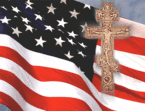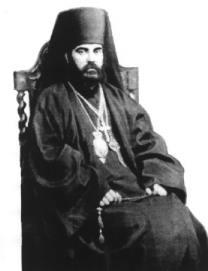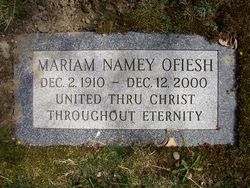Aftimios Ofiesh
| This article forms part of the series Orthodoxy in America | |

| |
| History | |
| American Orthodox Timeline American Orthodox Bibliography Byzantines on OCA autocephaly Ligonier Meeting ROCOR and OCA | |
| People | |
| Saints - Bishops - Writers | |
| Jurisdictions | |
| Antiochian - Bulgarian OCA - Romanian - Moscow ROCOR - Serbian Ecumenical Patriarchate: | |
| Monasteries | |
| Seminaries | |
| Christ the Saviour Holy Cross Holy Trinity St. Herman's |
St. Tikhon's St. Sava's St. Sophia's St. Vladimir's |
| Organizations | |
| Assembly of Bishops AOI - EOCS - IOCC - OCEC OCF - OCL - OCMC - OCPM - OCLife OISM - OTSA - SCOBA - SOCHA | |
| Groups | |
| Amer. Orthodox Catholic Church Brotherhood of St. Moses the Black Evangelical Orthodox Church Holy Order of MANS/CSB Society of Clerks Secular of St. Basil | |
| Edit this box | |
Aftimios Ofiesh (1880-1966, né Abdullah Aftimios Ofiesh, names sometimes spelled variously as "Oftimios," "Ofeish," or "Ofiesch") was an early 20th century Orthodox bishop in America, serving as the immediate successor to St. Raphael of Brooklyn under the auspices of the Church of Russia. He held the title Bishop of Brooklyn from 1917 until April of 1933, when he married, thus deposing himself from the episcopacy. He is perhaps best known in our day as being the source of numerous lines of succession of episcopi vagantes and led the American Orthodox Catholic Church for most of its existence. He died in 1966.
Contents
Life
Following the untimely death of St. Raphael of Brooklyn in 1915, Archimandrite Aftimios (Ofiesh) was elected to serve as his replacement in caring for the Arab Orthodox faithful in America under the Church of Russia's canonical authority. He was consecrated by Archbishop Evdokim (Meschersky) as an auxiliary bishop in 1917 with the title of Bishop of Brooklyn. In 1923, in recognition for his work in America, he was elevated by Metropolitan Platon (Rozhdestvensky) of New York to the rank of archbishop.
In 1924, in the canonical chaos of American Orthodoxy following the onset of the Bolshevik Revolution in Russia, the Arab Orthodox faithful split into two factions, one which wished to go under the canonical authority of the Church of Antioch and another which wished to stay faithful to the Church of Russia. The former group was organized by Bishop Victor (Abu Assaly) of New York, thus beginning the official presence of the Church of Antioch on American soil.
In 1927, Aftimios was commissioned by the Russian diocese in America to form an English-speaking "American Orthodox Catholic Church," which, despite Aftimios' leadership and vision, only lasted for six years. During this time, however, Aftimios consecrated three bishops for his new jurisdiction, Sophronios (Beshara) of Los Angeles, Joseph (Zuk) for the Ukrainians[1], and Ignatius (William Albert) Nichols in September of 1932 as his auxiliary bishop of Washington.[2] Additionally, in 1931 the Society of Clerks Secular of St. Basil, a Western Rite group, was established under the auspices of this diocese and subsequently led by Nichols.[3]
In 1932, Archbishop Aftimios was invited to come to St. Mary's Syrian Orthodox Church in Wilkes-Barre, Pennsylvania, to arbitrate a dispute regarding the transfer of its priest, Fr. Constantine Abou-Adal. When Fr. Constantine left St. Mary's in November of 1932, the parish was without a pastor, and so Archbishop Aftimios served in that capacity until February of 1933, organizing a choir and Sunday School at the parish. During this time, he met and became involved with one of St. Mary's parishioners, Mariam Namey, then subsequently married her in a civil ceremony in April of 1933.[4]

Reports vary at this point as to what happened regarding Aftimios' episcopacy. According to the parish records of St. Mary's, he "was retired" and lived in nearby Kingston until his death in 1966. With the withdrawal of support for the American Orthodox Catholic Church, it lost its canonical status. According to the book Orthodox Christians in North America (1794-1994), however, Aftimios "resigned his episcopacy and married."[5]
One of the groups which now traces itself to Aftimios characterizes the situation differently: "We are not under and do not have a patriarch as head of this Church since the ethnic patriarchal orthodox bodies all turned their backs on this Church and use the marriage of Abp. Aftimios as the reason, although most had already refused to recognize this Church and its authority in the New World."[6]
The biography by Ofiesh's widow Mariam claims that Aftimios fully intended to function as a married bishop, having that intent even before he met Mariam.
Whatever the case, relations between the small jurisdiction created by Aftimios and the mainstream Orthodox Church were not regularized following his marriage and de facto deposition from the episcopacy. Since that time, numerous and still multiplying lines of succession of episcopi vagantes continue to persist which all trace their roots to Aftimios (mainly through Ignatius Nichols), many of whom regard him as a saint.[7][8] Some of those bishops are married men, as well, which is a continual stumbling block to their unity with the mainstream Church, which has for centuries maintained a celibate episcopacy.
Following his death in 1966 at age 85, Aftimios was buried in Maple Hill Cemetery across from St. Mary's Orthodox Cemetery in Wilkes-Barre. His widow Mariam subsequently wrote his biography, published in 1999.
| Aftimios Ofiesh | ||
|---|---|---|
| Preceded by: St. Raphael of Brooklyn |
Archbishop of Brooklyn (Metropolia) 1917-1933 |
Succeeded by: Emmanuel (Abo-Hatab) |
| Preceded by: — |
Primate of the American Orthodox Catholic Church 1927-1933 |
Succeeded by: Sophronios (Beshara) |
Sources
- Orthodox Christians in North America (1794-1994), chapters 4 and 5
- History of St. Mary Orthodox Church (Wilkes-Barre, Pennsylvania)
- History of the American Orthodox Church (one of the groups which traces its roots to Aftimios)
- The Quest for Orthodox Church Unity in America, by Archim. Serafim (Surrency)
Book
- Ofiesh, Mariam Namey. Archbishop Aftimios Ofiesh (1880-1966): A Biography Revealing His Contribution to Orthodoxy and Christendom. Sun City West, AZ: Abihider Co., 1999. (ISBN 0966090810)
The book by Aftimios's widow, while including a great deal of historical information, is not mainly a scholarly work but is rather a biography aimed toward the exoneration of her late husband. One of its primary themes throughout is that Aftimios's marriage to Mariam was justified and that the canonical tradition of celibacy for Orthodox bishops is "man-made" and should be abolished.
External links
- Archbishop Aftimios Ofiesh, from THEOCACNA (see below)
- The Life of Archbishop Aftimios Ofiesh, from THEOCACNA
Writings
- A Basis for Orthodox Consideration of Unity, from the Orthodox Catholic Review, 1927 (PDF also includes header and footer information from one of the below groups, as well as numerous bracketed insertions)
Groups claiming succession from Aftimios Ofiesh
- Note: Though many of these groups use names which are very similar to mainstream groups, they are usually not affiliated with them in any way.
- American Orthodox Catholic Church, a.k.a. "The Holy Eastern Orthodox Catholic and Apostolic Church in North America (THEOCACNA) "American Orthodox Patriarchate" (other websites: theocacna.org,theocacna.us)
- American Orthodox Church, a.k.a. "North American Orthodox Church," "Western Orthodox Church of America," "Orthodox Catholic Church of the Americas," "American Orthodox Catholic Church" (not affiliated with THEOCACNA; operated by convicted pedophile and registered sexual offender Alan Stanford [9], [10])
- The American Orthodox Church (also Athonite Benedictine Fathers and Ukrainian Orthodox Catholic Church) affiliated with the Athonite Benedictine Monks
- The Ancient Apostolic Communion (TAAC), formerly The Coptic Orthodox Catholic Church (COCC)[11][12]
- The Anglican Independent Communion in the British Isles & Europe (AICUK)
- AnteNicene Episcopal Church of Christ (AECC), a.k.a. "The Primitive Episcopal Church"
- Belarus Autocephalous Orthodox National Church
- Byzantine Catholic Church, Inc. (Independent Jursidiction)
- Celtic Anabaptist Communion (CAC)
- The Continuing Episcopal Church (CEC)
- l'Eglise Gnostique Catholique Apostolique (EGCA)
- The Evangelical Catholic Church (ECC)
- The Grail Church (Apostolic Church of Jesus Christ)
- Holy Byzantine Catholic Orthodox Church
- Holy Orthodox Catholic Patriarchate of America (HOCPA), a.k.a. "Orthodox Church of America," "Standing Episcopal Conference of Orthodox Bishops"
- Iglesia Ortodoxa Bieolorrusa Eslava (Argentina)
- Igreja Ortodoxa Bielorrussa Eslava (Brazil)
- International Free Catholic Communion
- Mision Ortodoxa en Chile (Chile)
- Old Catholic Church of North America (OCCNA)
- Orthodox Church of the Far Isles (OCFI)
- Orthodox Order of the Missionaries of Mercy, a.k.a. "The St. Mary Institute," "Catholic Weddings Without The Hassle"
- The Pilgrims Guardianship
- Roman Orthodox Church (ROC), "Roman Orthodox Benedictine Congregation" (ROBC)
- Russian Orthodox Church in America (ROCIA)
- Spiritis Church, "The True Original Church"
- The International Free Protestant Episcopal Church (TIFPEC)
- Tridentine Catholic Church (TCC)
- United American Orthodox Catholic Church (UAO)
See also Episcopi vagantes.
Categories > Church History
Categories > OrthodoxWiki > Articles in a series
Categories > People > Clergy > Bishops
Categories > People > Clergy > Bishops > Bishops by century > 20th-century bishops
Categories > People > Clergy > Bishops > Bishops by city > Bishops of Brooklyn
Categories > Places > Orthodoxy by country > Orthodoxy in America


